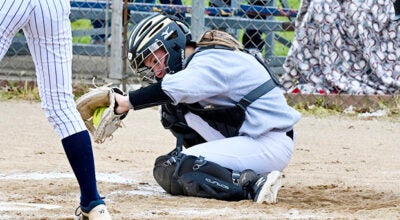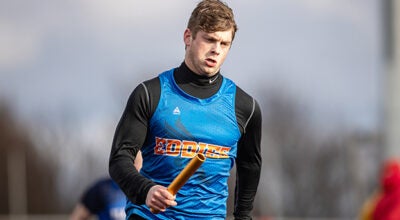Blythefield Country Club prepping for LPGA Classic
Published 8:44 am Wednesday, July 30, 2014

Bleachers have been constructed at Blythefield Country Club near Grand Rapids for the LPGA Classic, which runs Aug. 4-10. (Submitted photo)
GRAND RAPIDS — Several LPGA Tour players have visited Blythefield Country Club in recent weeks to play a practice round in preparation for the Aug. 4-10 Meijer LPGA Classic presented by Kraft.
And thank you notes followed to Patti Butcher, the director of golf and club operations.
“There were three things that showed up in each of the notes,” Butcher said. “They love the layout of the course, they love our greens and they think the members are super friendly.”
Blythefield members are excited to roll out their highly regarded golf course for the best women players in the world. American stars Michelle Wie, Stacy Lewis, Paula Creamer, Mo Martin and Morgan Pressel, who visited the club this week for a Meijer media event, are expected to compete as are almost all of the top 100 players on the LPGA Tour.
The golf course, a design of William B. Langford (1887-1977) and Theodore J. Moreau (1890-1942) dating to a 1929 opening, is sure to be a hit with the golfers. Allison Fouch-Duncan, a Grand Rapids native and recently retired LPGA Tour player who has played Blythefield many times, said the course will draw praise for many reasons.
“The older traditional great golf courses are loved by everybody on tour and we don’t get as many chances to play them these days,” she said. “The big modern courses are amazing and great, but courses like Blythefield have the great trees, perfect greens and test every club in your bag. The girls will love it, especially the girls who grew up in the Midwest playing classic courses like Blythefield. It’s really one of my favorite courses anywhere.”
Langford and Moreau, trained as engineers with Ivy League credentials, designed more than 200 U.S. golf courses through the 1920s, and many were in the Midwest. Blythefield is one of three in Michigan by the duo, with the others being the Country Club of Lansing and Marquette Golf & Country Club.
Lawsonia in Green Lake, Wisconsin, is considered a gem among the world’s top 100 courses, and they get credit for the redesign of a Donald Ross at Skokie Country Club in suburban Chicago, which is another course that often shows up in top rankings. Another highly regarded Langford and Moreau design is Wakonda Club in Des Moines, Iowa, which hosts a Champions Tour event (The Principal Charity Classic presented by Wells Fargo).
Collin Romanick, the golf course superintendent at Blythefield, said the LPGA officials who have visited are impressed with the design, condition and challenge Blythefield presents.
“They asked just one big thing of us really, and that was to build a tee for a 165-yard shot at our 15th hole,” he said. “We built a smaller tee there to create that shot. It really wasn’t a big deal and it turned out very nice. Everything we have done will benefit the membership going forward.”
The LPGA agronomist John Miller visited last month and liked the condition of the course so much that he doesn’t plan to return before the tournament is played.
“He said we had it under control,” Romanick said. “They asked for 3 inches in the rough (normal is 2 1/4 inches) and as thick as we can get it, so we are doing that, and they asked us to widen a couple of landing areas on two fairways slightly. Their desired green speed for the tournament is really what we offer day to day, right around 11 on the stimpmeter.”
Romanick said the weather in the days leading up to the tournament will dictate the final condition the professionals play.
“It could get faster and firmer and play very tough with the higher rough,” he said. “That can make it much harder to score on this course. I can’t predict a score, but hitting fairways will be important.”
The LPGA has switched things around primarily for the fan experience and room for grandstands, concessions, gallery traffic lanes and other logistics.
The nines have been switched, save for the real No. 18 continuing to be the No. 18 for the tournament, and No. 9 the No. 9 in the tournament. The actual No. 10 hole through No. 17 will serve as the first eight holes (Nos. 1-8) of the tournament set-up, and the back nine of the tournament will start at the actual No. 1, meaning for the tournament it is No. 10 and so on.
The No. 6 hole, which will be the 15th on the tournament set-up, will be played as a 400-yard par 4 as opposed to the 500-plus par 5 for members. That will make the course play at par 71 (the same par as in the 1953 Western Amateur, 1961 Western Open and 2005 Western Junior) over 6,414 yards as decreed by the LPGA Tour.
Romanick and Butcher said the switching of the nines will work.
“Brad Alexander (LPGA official) has been very creative in making sure the golf course is still a great test, and that the golf fans can move around and enjoy the action,” Butcher said. “I think it is set up for some excitement. There are birdies out there, but there are also some very difficult holes as always. It’s a great golf course and switching the nines around doesn’t change that.”
Fouch-Duncan, who visited the course two weeks ago, said the golfers who can shape their shots around the subtle bends of the design and avoid the trees will find success at Blythefield.
“You can make birdies because the greens roll so true and are in perfect shape, but you do have to control your golf ball off the tee and then shape shots both ways to hit greens,” she said. “It tests your whole game and your imagination. Competitive golfers love that.”






